Let me make it clear about how precisely CITES works
CITES functions by subjecting worldwide trade in specimens of chosen types to particular settings. All import, export, introduction and re-export through the ocean of types included in the meeting has become authorized via a certification system. Each Party to your meeting must designate one or higher administration Authorities responsible for administering that certification system and something or even more Scientific Authorities to advise them in the outcomes of trade regarding the status associated with types.
The types included in CITES are placed in three Appendices, in accordance with the level of security they require. (For extra information on the quantity and form of types covered by the Convention just click here.)
Appendices We and II

Appendix we includes types threatened with extinction. Trade in specimens of the types is allowed just in excellent circumstances.
Appendix II includes types definitely not threatened with extinction, however in which trade must certanly be managed to avoid utilization incompatible due to their success.
The Conference associated with the events (CoP), which can be the supreme body that is decision-making of Convention and comprises all its Parties, has agreed in Resolution Conf. 9.24 (Rev. CoP17) on a collection of biological and trade requirements to greatly help see whether a species must certanly be contained in Appendices I or II. At each and every regular conference for the CoP, Parties distribute proposals according to those criteria to amend both of these Appendices. Those amendment proposals are talked about after which presented to a vote. The meeting additionally permits amendments by way of a postal procedure between conferences for the CoP (see Article XV, paragraph 2, associated with meeting), but this action is hardly ever utilized.
Appendix III
This Appendix contains types which are protected in one or more nation, which includes expected other CITES Parties for support in managing the trade. Modifications to Appendix III follow a distinct procedure from modifications to Appendices we and II, as each Party’s is eligible to make unilateral amendments to it.
A specimen of the CITES-listed types might be brought in into or exported (or re-exported) from a situation celebration into the meeting as long as the document that is appropriate been acquired and presented for approval during the slot of entry or exit. There clearly was some variation of this demands in one nation to some other and it’s also constantly essential to check into the nationwide guidelines that can be stricter, nevertheless the fundamental conditions that apply for Appendices we and II are described below.
- An import license granted by the Management Authority for the continuing State of import is needed. This might be granted as long as the specimen is certainly not to be utilized for mainly purposes that are commercial in the event that import is likely to be for purposes that aren’t harmful towards the success regarding the types. When it comes to a real time animal or plant, the Scientific Authority should be satisfied that the proposed receiver is suitably prepared to house and take care of it.
- An export license or re-export certificate issued because of the Management Authority regarding the State of export or re-export can be needed.
An export license could be given as long as the specimen was legitimately acquired; the trade shall never be harmful towards the success associated with the types; plus an import license was already released.
A re-export certification might be given as long as the specimen was brought in prior to the conditions associated with Convention and, when it comes to a real time animal or plant, if an import license was given.
When it comes to a real time animal or plant, it should be ready and delivered to attenuate any danger of damage, harm to wellness or cruel therapy.
-
An export license or re-export certificate issued by the Management Authority associated with the State of export or re-export is necessary.
An export license could be given only when the specimen was lawfully acquired of course the export shall never be harmful towards the success for polyamorydate.com the types.
A re-export certification might be granted as long as the specimen was brought in according to the meeting.
When it comes to specimens introduced through the ocean, a certificate has got to be released by the Management Authority regarding the State into that the specimens are now being brought, for types placed in Appendix We or II. For more information, start to see the text of this meeting, Article III, paragraph 5 and Article IV, paragraph 6.
- An export permit issued by the Management Authority of that State is required in the case of trade from a State that included the species in Appendix III. This might be given as long as the specimen was lawfully acquired and, when it comes to a real time animal or plant, if it’s going to be ready and delivered to reduce any chance of damage, injury to wellness or cruel therapy.
- In the event of export from just about any State, a certification of beginning given by its Management Authority is necessary.
- In case of re-export, a re-export certification granted because of the State of re-export is necessary
Exemptions and unique procedures (see page that is separate additional information and links)
With its Article VII, the meeting enables or calls for events to make sure exceptions towards the basic axioms described above, particularly within the following instances:
- for specimens in transportation or being transhipped [see Resolution Conf. 9.7 (Rev. CoP15)];
- for specimens which were obtained before CITES conditions put on them (referred to as pre-Convention specimens, see Resolution Conf. 13.6 (Rev. CoP18);
- for specimens which are personal or home impacts [see Resolution Conf. 13.7 (Rev. CoP17)];
- for pets that have been вЂbred in captivity’ [see additionally Resolution Conf. 10.16 (Rev.)];
- for flowers which were вЂartificially propagated’ [see additionally Resolution Conf. 11.11 (Rev. CoP18)];
- for specimens which can be destined for medical research [see additionally Resolution Conf. 11.15 (Rev. CoP18)];
- for animals or flowers part that is forming of travelling collection or event, such as for example a circus [see additionally Resolution Conf. 12.3 (Rev. CoP18)].
You will find special guidelines in such cases and a license or certification will generally speaking be required still. Anybody about to import or export/re-export specimens of the CITES types should contact the CITES that are national Authorities for the nations of import and export/re-export for info on the principles that apply.
Each time a specimen of A cites-listed types is transported between a nation this is certainly a Party to CITES and a nation that isn’t, the united states that is an event may accept paperwork equal to the licenses and certificates described above.

